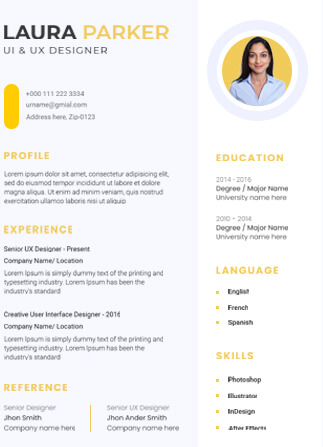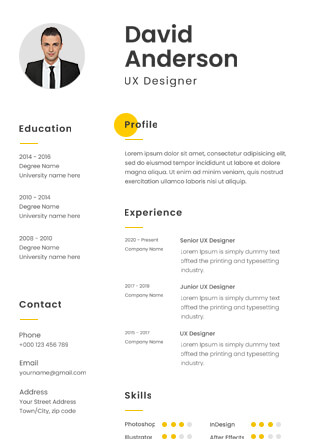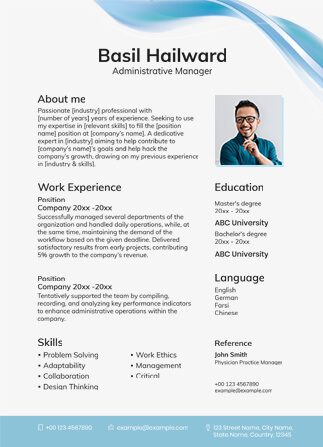Mechanic Resume Examples – Get Hired for the Best Jobs
The transportation industry is rapidly changing, but this evolution comes with its own set of challenges and opportunities. To overcome such challenges and capitalize on the opportunities, a huge demand for skilled “Mechanics” has been created. It is believed that this trend will continue an upward trajectory in the future.
Candidates seeking employment in the transportation industry always have an opportunity to work with the leading companies of the sector, excel, and grow. The process of getting hired, however, starts with sharing your resume with potential employers. Needless to say, an impressive, well-structured “Mechanic” resume is vital for success. But what makes a resume truly impressive? The secret lies in telling your professional journey impressively. It should be well-documented, easy to read and highlight your achievements as per the job you wish to secure.
So what’s stopping you from advancing in your career? Make the right move, hire a professional resume writing company with a proven track record of creating job-winning Mechanic resume examples.

Stand Out With a Resume Made from Our Fault-Proof Mechanic Resume Examples
A mechanic’s resume must include both hands-on experience and training to compel the recruiter. Considering the fact that a resume is a marketing copy of yourself, you have to paint the best of your abilities to get hired. A mechanic’s resume must include hands-on experience and training to impress the recruiter.

It’s okay if you are not ready to make an investment in advancing your future at the moment. This guide will provide you with insights and tips to create a perfect resume. Our Auto mechanic resume examples are an excellent starting point for you. You’ll learn:
- What resume formats are there and which one to use?
- How to make an impressive Mechanic resume?
- How to make a lasting impression?
- Dos and don’ts of “Mechanic” resume.
Mastering Mechanic Resume Writing: Best Practices for 2023
Would you like to make a strong impression on your future employer? First of all, you must have an impressive resume. The ideal resume is concise and well-structured and does not contain unnecessary details. How to create an impressive “Mechanic” resume? Here are some tips for getting the perfect resume that gets to the interview!
Mechanic Resume Format Options
Let’s start with the resume format options.
The most common and accepted resume format is the chronological one. This presents your career in the form of an overview of the functions you have already held and the corresponding achievements. List them in reverse; put the most recent first. Pay more attention to recent jobs, as these are probably the ones where you have gained the most relevant experience.
In some cases, a functional resume is more suitable. This consists of grouping all your experiences according to your skills or responsibilities. A functional resume is, therefore, a kind of portfolio and can, for example, be useful for creative profiles.
However, sometimes a hybrid of these two formats is used, which is ideal for more experienced candidates. This option may come in handy if you are planning to customize your resume for your target job.
An Impressive Mechanic Resume Is Well-Structured
There’s no doubt that a professional Mechanic resume is the key to unlocking the door to your dream job. This is why it is important not to leave anything to chance and craft a brilliant “Mechanic” resume that catches the right eye.
To ensure that your “Mechanic” resume is perfect, you need to ensure that:
- The layout is neat, easy on the eyes, and clear;
- It’s structured using the right “Mechanic” resume example
- It is designed keeping your target audience in mind
- Your objective or goal for the target job is clear
don’t forget to customize it a bit as per the job description.
Prefer Rationality Over Creativity
Never overdo your “Mechanic” resume in order to appear creative. A professional “Mechanic” resume presents your educational and professional background in a logical and understandable way to the reader. Don’t use too many visual elements that divert the attention of the potential employer.
Here are some additional tips to stay focused on rationality:
- Your “Mechanic” resume should not be more than 2 pages
- Mention the skills or accomplishments that are relevant to the target job, even if they are less important in your current job or if they are less recent.
- Remove superfluous details (marital status, children, beliefs, political preferences, etc.) from your resume.
- Avoid clichés like 'likes to take initiatives,' 'is a team player,' 'natural leader,' or 'good communicator.’ Preferably list concrete accomplishments.
- Avoid gaps and inaccuracies so as not to waste precious time during the job interview.
- Write in the present: your skills and talents are indeed valid in an unlimited way.
- Focus on the positives.
A good resume is more than a list of functions and accomplishments. It also reflects how you achieved certain goals. The more concretely you explain your accomplishments, the more you demonstrate the added value you represent to your potential employer.
Fine-tune Your Resume
Now that you have selected a good layout – it’s time to fine-tune it. How? Well, you should start by printing your resume and evaluating the electronic copy as neutral. If you can’t do that – ask a friend to help you. You should remain objective while evaluating it and ask questions like is the information clear? Is it visually appealing? Is there anything out of alignment?
You can mention skills that are not directly related to your job. Your activity in a sports club can absolutely influence your ability to carry out a certain function.
Your resume should give an idea of your long-term potential. If you are currently studying for an additional qualification, mention that as well. This shows that you like to learn and improve yourself continuously.
- Mention your professional qualifications, your secondary and post-secondary diplomas, as well as recent courses taken in a professional setting. Indicate where you followed them.
- Add your knowledge of foreign languages. Be honest about it.
- Do you have interests that are out of the ordinary? Mention them if they may be of interest to the potential employer.
- Do check for typos and errors in your “Mechanic” resume.
- Don’t add a list of all courses you have taken.
- Don’t mention your political preferences.
- Don’t lie about your knowledge of languages.
- Don’t mention mundane interests that have no connection to the job posting.
- Don’t provide salary or any other personal details that are of no use to the potential employer.
How to Build a Mechanic Resume from Scratch?
Typically, a simple “Mechanic” resume should contain:
- Personal data
- Area of expertise and professional objective
- Academic qualification
- Professional experience
- Courses and qualifications
- Interests and hobbies related to the job
Below, we’ll explore each of these topics further and give you some suggestions for what you can put into them.
How to Make An Effective Mechanic Resume?
A good resume is not always the most extensive. The document should offer a summary of your professional life so that the recruiter evaluates your suitability for the role without wasting time reading lengthy paragraphs (after all, there are other candidates).
So how do you stand out without being verbose?
1. Put personal data and contact information in the header
This is a standard practice and allows potential employers to know how to contact you if you get shortlisted. This section should contain the necessary details, including:
- Your Full Name (if more than one last name, enter only the last);
- Address, City (State), and Zip Code;
- Phone number
- Personal email (but if it's something like "animefreak1999@example.com" I suggest creating a new account like "yourfullname@example.com");
- Link to a personal website, portfolio, or LinkedIn profile.
Right after your contact details, you can also identify the current role you are in or the one that you are targeting – this is called a Headline. Be direct and concise in this area. If you want to become a “Mechanic,” write that only. Otherwise, “Experienced Mechanic;” or “Automotive repair technician” would do just fine. But don’t overdo or oversell.
2. Write a brief but impactful professional summary
A professional summary works like a hook. It can convince the potential employer to review your entire resume and shortlist you OR reject you right away. This section should not be more than a paragraph and should tell your professional tale in an impressive manner.
However, it is important to be objective in this section and avoid excessive use of adjectives. For example, don’t say things like you are “proactive” and “reliable.” Instead, present the facts that show them that you’re proactive and reliable by highlighting your achievements.
The ideal approach to writing a summary is to answer the question in a prudent way: Why should the company hire you, and what value can you bring to the table?
3. Highlight Your Key Skills
This section can come right after the professional summary or on the left side of the document. In this field, you should mention skills that are relevant to the job you are targeting. This increases the chances of your “Mechanic” resume being selected in the first screening.
4. Talk about your professional experience
This is the story you need to tell the recruiter. The idea is to list your professional experiences, starting with the most recent and moving to the oldest. In each item, you must describe the activities you carried out and, whenever possible, the results you achieved.
- Company name + brief description about the segment, size, and state;
- Position + start/end date
- Your responsibilities (ideally, it should be relevant to the job you are targeting) plus your achievements (if any).
Always use action verbs when explaining your job roles, responsibilities, or achievements.
5. Enter your academic credentials
After your professional experience section comes your academic credentials. Here, the idea is to list your education, especially undergraduate and graduate degrees, if you have them, and technical courses related to your area of interest. It should ideally be presented in the following format:
Course/Degree Title (Year of Completion), Institute’s Name
It is worth noting that you should start with the last degree/course you’ve completed.
6. Include supplementary job-related certifications
This doesn’t have to be a separate section. It can either be a subheading under the academic credentials section or just be there. Here, in this section, it is worth highlighting the courses that are linked to your area of interest. Outdated courses, which are no longer useful, can be discarded.
You should use the academic credentials format mentioned above to mention job-related certifications.
7. Talk about your language proficiency and the tools/software
Some additional information that is not directly related to the previous fields may attract the attention of the recruiter. If you are available to travel, for example, you can use this space to say so. If you are fluent in English and have basic knowledge of Spanish, too. It’s always advised to mention the level of fluency you have when it comes to language skills:
- Native
- Fluent
- Proficient
- Intermediate
- Basic
If you know specific software in your area or know everything about Excel, that’s it: this is the place to deal with these matters.
List your knowledge of the tools used on a daily basis in the desired career (Inventory and part management software, CRM, Diagnostic Software). Also, you should include your knowledge of languages, always indicating the level. You can also use this section to showcase your possible availability (moving, travel, schedule, etc.).
If you participate in any groups, such as a council, institution, or NGO, highlight your contribution to society.
8. Insert additional information
Do you have more information to share, but it doesn’t fit any topics above? This is the place to talk about them. If you have hobbies, have already done an exchange program, or have participated in an important lecture, give this information to the recruiter. It’s important to be careful to only include what is relevant to the position you want to take or the company you want to work for.
Tips for a Mechanic Resume: Examples You Should Follow
The job application process has been automated in almost every company regardless of the company size or industry. This increases the probability that your “Mechanic” resume will have to first clear the initial evaluation by any Applicant Tracking System.
This indicates that in order to be shortlisted for the target job, you must use appropriate keywords in your resume. Availing the services of a professional resume writing company near you is the way to go about it. However, if you are planning to roll up your sleeves and do it yourself, then we have some tips for you.
Applicant Tracking Systems or ATS may appear complex but in reality they are not. The only prerequisite is that you should know how these systems work inside-out.
First of all, you need to tailor your resume for the “Mechanic” job that you are applying to. You need to carefully read the job ad in detail to mark the keywords mentioned in it. For instance, if the job ad has keywords like “problem solver,” “detail oriented,” or “excellent communicator,” then you should update the skills section in your “Mechanic” resume accordingly.
What Do Recruiters Look for in A Resume?
Generally, the information that recruiters look for most in the resume is: “Headline,” that is, the position that you want to occupy; “Professional summary”, where you, in a paragraph, should explain who you are, and “Professional experience,” which identifies the roles and responsibilities with previous employer(s) as well as accomplishments.
It is important to consider that recruiters give preference to updated resumes. So it’s important to make periodic updates to yours.
How to Get Attention Without Having Professional Experience?
When you don’t have the professional experience to count on your resume, you can use: academic experiences – for example, from college or school and volunteer activities.
Customer Reviews



About Us
We, at Finest Resume Writing Services, believe that most candidates lose out on their career-defining opportunities due to their resumes. An impressive and professional resume can make all the difference and lead you to success. This is where we come in and saves the day for you. Our team of professional resume writers can write on every niche and has the required experience to help you stand out from the crowd.
Whatever your target job is, our professional resume writers can help you land an interview like a breeze. We have experts from transportation, finance, accounting, supply chain, marketing, operations, management, sales, manufacturing, engineering, and all the fields who work with you to understand your requirements and tell your professional journey in a way that gets you shortlisted. Our consultants also help you with cover letters and LinkedIn profile optimization so that you can put your best foot forward and make a lasting impression.
Quick Questions
Apart from being good with automotive repairs and having the required technical skills, “Mechanics” should have the following soft skills:
- Problem Solving
- Analytical
- Excellent Communication
- Conflict Resolution
- Client Handling
- Negotiation
- Technical
They are required to wear different hats as part of their duties, which is why highlighting your soft as well as hard skills on your resume is very important.
An ideal way to describe yourself as a “Mechanic” is to have an objective, customized professional summary that tells the recruiters who you are and what you bring to the table. For instance:
“A self-starter with over X years of experience in the transportation industry and the ability to handle difficult situations in compliance with the internal standards and other regulatory requirements.”
Writing a “Mechanic” resume with no experience requires that you:
- Develop a catchy header
- Write an attractive professional summary showcasing your career objective or what drives you
- Provide the list of your academic credentials and achievements
- Prepare a skills section where you provide all the necessary skills as per the job ad
- Proofread your resume for any typos, errors, or mistakes.
To prepare for the interview, you should carefully consider the job description and focus on the skills that they seek in an ideal candidate. For instance, you can highlight your skills to handle customers and satisfy their needs.
30+ “Mechanic” skills you should add to your resume:
- Active listening
- Adaptability
- Analytical skills
- Attention to detail
- Communication
- Compliance knowledge
- Computer literacy
- Conflict management
- Conflict resolution
- Customer relationship management
- Customer service
- Documentation
- Integrity
- Multitasking
- Negotiation skills
- Organizational skills
- Problem-solving
- Product knowledge
- Productivity
- Sales skills
- Salesmanship
- Stress management
- Teamwork
- Time management
- Detail-oriented
- Diagnosis
- Preventive Maintenance.
- Schematics.
- Hand Tools.
- Automotive Safety
- Parts Identification
A mechanic’s resume should contain problem-solving skills, attention to detail, versatility, agility, and troubleshooting capabilities. You can add soft and hard skills since an auto mechanic has to deal with customers and propose a solution simultaneously.
According to the Bureau of Labour Statistics (BLS), mechanics should obtain industry-specific certification as soon as they get employed. If a mechanic is hired to repair car air conditioning, they must be certified to work with refrigerants.
It is a call for employment for mechanics containing all the information regarding the roles and responsibilities of the potential employee and the eligibility criteria.








